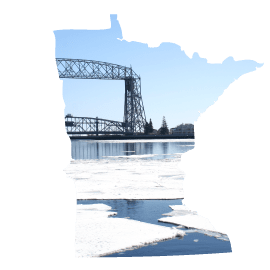Licensure Requirements: Minnesota
Special Education Teacher Preparation Policy
Analysis of Minnesota's policies
Unfortunately, in addition to one grade-specific option (birth-grade 1), Minnesota offers a K-12 mild to moderate special education certification.
Recommendations for Minnesota
End licensure practices that fail to distinguish between the skills and knowledge needed to teach elementary grades and secondary
grades.
The broad K-12
umbrella is deeply problematic for the overwhelming majority of high-incidence
special education students, who are expected to learn grade-level
content. Minnesota—at the very
least—should offer high-incidence elementary and secondary special education licenses and
require special education teachers to have the appropriate license for the
grade level of students with whom they are working.
State response to our analysis
Minnesota listed the other special education licenses offered by the state:
Autism (8710.5850),
Physical Health Disabilities (8710.5800),
Deaf or hard of hearing (8710.5200),
Blind Visually Impaired (8710.5100) is birth through age 21
Oral/aural deaf education (8710.5250) is birth through grade 12
Learning disabilities (8710.5700),
Emotional Behavioral Disorders (8710.5600),
Developmental Disabilities (8710.5400) is kindergarten through age 21
Developmental Adapted Physical Education (8710.5300) is preK through age 21
Updated: February 2020
Select another topic
Teacher Preparation
- Program Entry
- Teacher Shortages and Surpluses
- Program Performance Measures
- Program Reporting Requirements
- Student Teaching/Clinical Practice
Elementary Teacher Preparation
Secondary Teacher Preparation
- Middle School Content Knowledge
- Middle School Licensure Requirements
- Secondary Content Knowledge
- Secondary Licensure Requirements
Special Education Teacher Preparation
Alternate Routes
Teacher Diversity
Hiring
Teacher and Principal Evaluation
Teacher Compensation
Early Childhood Preparation
Retaining Effective Teachers
How we graded
4C: Special Education Licensure Requirements
- Specific Licensure: The state should require its teacher preparation programs to sufficiently distinguish between the differing needs of high-incidence elementary special education teachers and high-incidence secondary special education teachers by requiring distinct elementary and secondary special education licenses.
The total goal score is earned based on the following:
- Full credit: The state is only eligible for the full point if it requires teacher preparation programs to sufficiently distinguish between the differing needs of high-incidence elementary special education teachers and those of high-incidence secondary special education teachers by requiring distinct elementary and secondary special education licenses. The state is not eligible for any credit if it offers K-12 special education licenses either in isolation or as an alternative to grade-specific licenses.
- One-quarter credit: The state is eligible for one quarter of a point if, in addition to K-12 special education licenses, the state offers both high-incidence elementary and secondary licenses.
Research rationale
Generic K-12 special education licenses are inappropriate for teachers of high-incidence special education students.
Too many states make no distinction between elementary and secondary special education teachers, certifying all such teachers under a generic K-12 special education license. While this broad umbrella may be appropriate for teachers of low-incidence special education students, such as those with severe cognitive disabilities, it is deeply problematic for high-incidence special education students, who are expected to learn grade-level content.[1] And because the overwhelming majority of special education students are in the high-incidence category, the result is a fundamentally broken system.
It is virtually impossible and certainly impractical for states to ensure that a K-12 teacher knows all the subject matter he or she is expected to teach. Further, the issue is just as valid in terms of pedagogical knowledge. Teacher preparation and licensure for special education teachers must distinguish between elementary and secondary levels, as they do for general education.[2] The current model does little to protect some of our most vulnerable students.
[1] Levenson, N. (2011). Something has got to change: Rethinking special education (Working Paper 2011-01). American Enterprise Institute for Public Policy Research. Retrieved from http://eric.ed.gov/?id=ED521782
[2] Feng, L., & Sass, T. R. (2010). What makes special education teachers special? Teacher training and achievement of students with disabilities (Working Paper 49). National Center for Analysis of Longitudinal Data in Education Research. Retrieved from http://www.urban.org/UploadedPDF/1001435-what-makes-special.pdf; Levenson, N. (2011). Something has got to change: Rethinking special education (Working Paper 2011-01). American Enterprise Institute for Public Policy Research. Retrieved from http://eric.ed.gov/?id=ED521782

